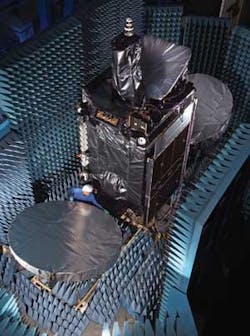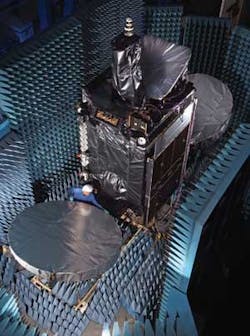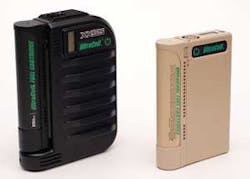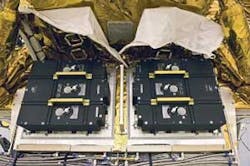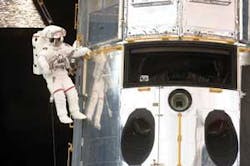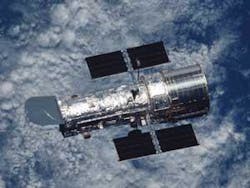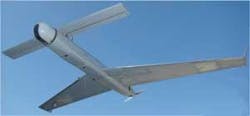Electrifying advancements
Defense organizations and industry combine efforts and expertise to deliver safe, reliable, and readily available power when and where needed.
By Courtney E. Howard
Warfighters, first responders, and astronauts all rely on an ever-increasing amount of electronics to get their jobs done. These electronic devices, no matter how novel, innovating, or automated, require adequate, reliable, and long-lasting electric power.
Power—including its supply, conversion, storage, and management—is at the forefront of most every engineer’s mind. Indeed, virtually every engineer, system designer, system integrator, and project manager working on military and aerospace electronics is confronted by size, weight, and power requirements. The latter, and perhaps the most crucial of the three, is the focal point of many technology firms and defense organizations today.
Power needs
Today’s mil-aero environments require “smaller, lighter products that can provide efficient power to systems,” says Tim Jors, business unit leader of standard power at the Electronics Group of Crane Aerospace & Electronics in Redmond, Wash. “Overriding all of this is reliability; it must work first and always.” At the same time, he says, customers are constantly making trade-offs based on cost, performance, and specs when choosing components. “Non-hermetic products are getting better and better and are more reliable than in the past, and customers are willing to qualify a non-hermetic, or commercial off-the-shelf (COTS), component for their designs.”
The mil-aero market is slowly shifting power architectures that are driving the need for bus control modules and point of load products, Jors says. “We see growth in intermediate bus architecture products. The market is asking for lower voltages for digital systems, along with higher efficiency, low noise, and smaller size packages.”
The space market is changing to higher-voltage bus architectures to reduce cable size and weight, and other system requirements, Jors continues. “The future in space power electronics needs new products to address high-voltage (120-volt bus) needs and point of load products.”
Sightseeing in space
Servicing Mission 4 (SM4), also known as shuttle mission STS-125, marked the final astronaut mission to the Hubble Space Telescope. Power Solutions of Crane Aerospace and Electronics in Redmond, Wash., provided power supplies, including the Interpoint brand SMRT series of DC/DC converters, to help NASA astronauts repair the Hubble Space Telescope on SM4.
“Over the course of five spacewalks, astronauts installed two new instruments, repaired two others, and replaced a number of components essential to the telescope’s smooth functioning, such as batteries and insulation,” says a NASA representative.
Crane DC/DC converters, integral to repairing the Hubble’s power supplies, provide power to the telescope. The SMRT Series of DC/DC converters offer as much as 35 watts of power in a radiation-tolerant environment, says a Crane representative. The converters, deployed for the first time in space, are for use in programs requiring high reliability, light weight, small size, and high levels of radiation-hardening assurance.
“We responded to an urgent need for new power supplies to refurbish the systems on the Hubble Space Telescope,” explains Jay Kuehny, site technology leader and principal engineer for Crane Electronics Group, Power Solutions. “The power supplies being replaced had been functioning for more than a decade, allowing the Hubble to keep sending fantastic photographs of our universe. We helped in the design of the new power supplies and proceeded to develop the hardware in the needed timeframe for NASA’s program.”
NASA officials anticipate the recent repairs will extend the Hubble’s life until 2014.
“Systems in space are rarely serviced; the International Space Station and the Hubble Space Telescope are the exceptions,” Jors says. “They require power conversion products that are extremely reliable (MIL-PRF-38534, Class K, Space Grade). These systems also need radiation-hardened devices so that extended and reliable operation can be guaranteed.”
The Hubble Space Telescope’s Space Telescope Imaging Spectrograph (STIS), built by Ball Aerospace in Boulder, Colo., had a power board that needed to be replaced, adds Jors. “We worked with NASA Goddard Space Flight Center (GSFC) to optimize a solution for them that reduced the number of devices that they needed and provided more reliability and performance for the system. This resulted in a power system design that is more reliable and efficient, less noisy, and lighter weight that was installed and is operational.”
Satellite solutions
The MEASAT-3a communications satellite launched into space in June 2009 with Saft batteries onboard. The rechargeable lithium-ion (Li-ion) batteries from Saft in Cockeysville, Md., power the MEASAT-3a during two eclipse seasons per year when the spacecraft is blocked from the sun.
Built by Orbital Sciences Corp. in Dulles, Va., and powered by Saft’s Li-ion technology, the MEASAT-3a employs two of Saft’s VES 140 batteries onboard, for a total of 72 VES 140 cells. Saft’s batteries are designed to offer energy and weight savings compared to other power supply solutions. By substantially decreasing the weight, the MEASAT-3a can dedicate more of its crucial mass to the payload, creating a more powerful satellite, says a company representative.
“With the launch of MEASAT-3a, Saft Li-ion battery technology is now represented in a total of 33 spacecraft currently in orbit,” reveals Thomas Alcide, general manager of Saft’s Special Battery Group.
In August, Saft won a $9 million contract to deliver to an unnamed U.S. government satellite program batteries with Saft’s VL 48E (48Ah) cells, which are configured to meet the satellites’ bus size and power needs. The battery features high specific energy (150 kW/kg) and is qualified to provide power throughout the full life of the satellite.
Saft has provided batteries for other Orbital-built satellites, including the Optus D1, D2, and D3, as well as the Horizons-2 and THOR 5 satellites. Orbital’s KOREASAT 6 also is in the process of being manufactured with Saft Li-ion batteries onboard and is scheduled for launch in 2010. In addition to satellites, the company’s space Li-ion technology has been used in space applications such as launchers, space vehicles, probes, power tools, and planetary rovers.
A hot topic
Delivering sufficient power on the battlefield is no mean feat, especially in the high-heat environments that today’s warfighters face.
“Both our product lines are affected by the high operating temperature of the Middle East,” says Jeffrey VanZwol, marketing director at Micro Power Electronics, a manufacturer of battery packs and chargers in Beaverton, Ore.
The company’s vehicular mounted battery chargers typically operate in the back of a military transport vehicle, where it is assaulted by many heat sources: an integrated power converter or supply, the printed circuit board assembly, and the batteries that heat up while they are being charged.
“A high ambient temperature can contribute to the heating of the batteries,” VanZwol notes. “The battery temperature is of primary concern, as a battery under charge can elevate in temperature.” Batteries should not be charged above 45 degrees Celsius, and batteries start to deteriorate above 60 degrees C. Micro Power’s battery chargers monitor the temperature of the batteries in the charging bays, and progressively regulate charge current as the battery temperature elevates above 45 degrees C, he explains.
Micro Power’s research-and-development efforts continue to focus on high-power battery packs and chargers. “High-rate batteries, using a lithium iron phosphate formulation, can deliver hundreds of amps of current,” VanZwol says. “High-power batteries can discharge high currents, and similarly, they can also accept high charge currents (i.e., fast charge). This new battery technology is applicable to motorized applications, such as small unmanned vehicles or small motorized vehicles.”
Unmanned and unplugged
Powering unmanned vehicles, especially unmanned aerial vehicles (UAVs), has long been a challenge facing engineers. Batteries, no matter the technology or metallic makeup, are heavy and small UAVs cannot typically support the weight.
Engineers at Aurora Flight Sciences needed lightweight batteries to support its Excalibur vertical take-off and landing (VTOL) prototype. They selected Li-ion batteries from EaglePicher Technologies LLC, a producer of batteries and energetic devices for the defense, space, and commercial industries in Joplin, Mo.
“Li-ion cells provide energy storage at a third of the weight of traditional nickel-based systems with excellent cycle life,” says a company official. EaglePicher’s Li-ion batteries also combine lightweight aluminum components and adhesive Room Temperature Vulcanizing, an elastomer sealant, to further minimize battery weight.
The Excalibur’s hybrid turbine-electric propulsion system uses a tilting engine for primary propulsion and electric lift fans, which are powered by EaglePicher’s Li-ion batteries for supplemental thrust and control during VTOL. EaglePicher officials anticipate the new approach could lead to broader applications in avionics.
“This program is an important part of next-generation aviation operations,” says Randy Moore, president of EaglePicher Technologies, “and we look forward to being a part of what this program will accomplish and how it will change aircrafts of the future.”
Featuring fuel cells
The future may be closer than we may think. BlueBird Aero Systems in Israel and Horizon Fuel Cell Technologies in Singapore, have introduced the Boomerang long-endurance, commercial hydrogen fuel cell-powered unmanned aerial system (UAS). Boomerang debuted during the Association for Unmanned Vehicle Systems International (AUVSI) Unmanned Systems North America 2009 conference in Washington, D.C., in August. Horizon, maker of light and compact electrical energy storage systems, also launched at the event its AEROPAK self-contained 2kg fuel cell power system able to deliver 900 watt hours (Wh), which can increase the flight endurance of small and stealthy UAS by as much as 300 percent.
BlueBird’s Boomerang field-operational, 9-kilogram, electric-powered UAS can fly more than nine hours using Horizon’s high-performance, hydrogen-electric power system. With Boomerang, BlueBird Aero Systems engineers conclude a three-year effort to integrate proton exchange membrane (PEM) fuel cell technology into a specially designed UAS, developing support systems such as hybrid capabilities for system power redundancy and a fuel-cell cooling mechanism.
“The unique ability to perform long endurance missions with a mini UAS, as presented by BlueBird’s Boomerang, is a great benefit especially for border patrol, infrastructure surveillance, critical assets, and environmental monitoring missions,” says a company representative. “In addition to increasing flight endurance, Horizon’s new fuel cell system also makes it possible to increase the capability of smaller and lower cost aircraft by integrating more power draining electronic devices, such as electro-optical sensors, infrared cameras, and laser designators.”
The Boomerang fuel cell-powered UAS is licensed for flights in Israel and is graded as a “matured” system.
Supply at sea
Military electronics applications at sea bring their own unique requirements and power needs, which industry technology firms are striving to meet. Engineers at DRS Technologies Inc. in Parsippany, N.J., sought the optimal energy storage system for the company’s Integrated Fight Through Power (IFTP) system on U.S. Navy’s future DDG 1000 destroyers, multi-mission surface combatants tailored for the littoral, air, and sub-surface warfare. They chose Saft’s Lithium-ion technology, awarding more than $1 million in contracts for its high-power batteries.
“Given the U.S. Navy’s stringent battery requirements, the introduction of our Li-ion technology into the DDG 1000 platform marks a huge milestone for Saft,” says Thomas Alcide, Saft Specialty Battery Group general manager.
Saft’s rechargeable Li-ion batteries will support key functions within the IFTP system, which not only sustains the destroyers’ integrated power systems (IPS), but also provides the means for conversion and distribution of the ships’ service power to various shipboard weapons, sensor systems, and auxiliary systems, according to a representative.
Saft engineers are developing 12 batteries using VL 34P cells for each destroyer with custom electronics, housing, and an integrated charger to support the IFTP’s Load Center breakers. These breakers enable the system to shut down electronically, even when no power is present.
The company will also provide 22 batteries, again based on VL 34P cells, for each ship for the IFTP’s Housekeeping Power Supply (HKPS). These batteries will supply onboard back-up power until the destroyers’ loads can be shut down.
The VL 34P cells have been employed in military hybrid-electric vehicle applications to support battery-only operation, silent watch, and drive assist. Saft engineers developed the technology to operate at high temperatures (up to 70 degrees C), maintain performance over a long lifetime, and deliver high power and long run times for various military applications.
Portable power
Soldiers in the field, already laden with heavy packs of electronics systems, are increasingly adopting fuel cell technology in lieu of traditional or rechargeable batteries. U.S. Army officials, recognizing the need for lightweight, portable power in the field, continue to invest in the advancement of fuel cells.
DuPont of Wilmington, Del., and SFC Smart Fuel Cell AG or Brunnthal, Germany, won a follow-up order at the end of July from the U.S. Army for the development of the M-25 fuel cell. The M-25 is a small, lightweight, portable power supply that can extend soldier mission times to 72 hours or more. The M-25 program, which was awarded $1 million by the U.S. Department of Defense Wearable Power Prize in October 2008, is estimated at $3 million.
The M-25 is part of an integrated body-worn power source that combines DuPont’s direct methanol technology with SFC’s fuel cell systems. “This technology is a decisive advantage and DuPont is proud to partner again with SFC to address the need for a lightweight, long endurance power system for soldiers,” says John D. Colven, global business manager at DuPont Fuel Cells. “The integration of our membrane electrode assembly technology within SFC direct methanol fuel cell systems will further the success of fuel cell power solutions in defense applications.”
The M-25’s standard design, when worn by soldiers in the field for extended missions, is up to 80 percent lighter than conventional power sources, yet capable of powering a wide range of soldier equipment, according to a representative. The technology is designed to offer a significant weight reduction when compared to conventional battery systems for multi-day missions, and deliver quiet and continuous energy to power digital communication and navigation equipment.
“There is significant potential for portable and vehicle-based autonomous power applications that require full systems solutions combining fuel cells and batteries as a system,” says Peter Podesser, chief executive officer of SFC hiFuel Cell AG. “Fuel-efficient, lightweight, silent, and emission-free power sources are a unique way to achieve customer requirements and ultimate customer satisfaction.”
Soldier-borne systems
U.S. Army officials have also turned to UltraCell Corp., a producer of fuel cells for mobile power applications in Livermore, Calif., to innovate in the area of soldier-worn power supply technology.
UltraCell won a U.S. Army Communications-Electronics Research, Development, and Engineering Center (CERDEC) contract to build fuel cell systems based on the company’s XX55 reformed methanol fuel cell (RMFC) technology. The goal of the CERDEC contract, which extends through March 2010, is the production of working fuel cell systems capable of delivering more than 50 watts of continuous power for a 72-hour, off-grid mission. During that time, the systems must be capable of powering portable electronics equipment, such as radio and satellite communications devices, remote and mobile surveillance systems, and laptop computers, as well as recharging batteries in the field.
“Reliable, lightweight, and portable power continues to be a vital need for the soldier,” says J.J. Kowal, part of the CERDEC fuel cell technology team. “This award will allow UltraCell to design a reliable, next-generation system capable of delivering extended power for soldiers during off-grid missions throughout the world.”
UltraCell personnel will build five units for U.S. ground forces in the Army and Air Force. The company’s XX55 is an ultra-compact, rugged, portable fuel cell equipped with a hybrid battery system capable of delivering 55 watts of continuous power and 80 watts peak power.
UltraCell engineers also will build fuel cell systems for the U.S. Army Agile Integration Demo and Experimentation (AIDE). Part of the Army’s Research, Development, and Engineering Command (RDECOM), AIDE serves as a collaboration center targeted at accelerating the delivery of novel technology to meet warfighters’ requirements.
UltraCell will initially build 30 fuel cell systems to provide “higher energy density, a greater operating life, increased performance at higher altitudes, and a greater threshold for maximum ambient temperature than previous portable power solutions—while offering a lighter and more mobile design,” says a representative.
“The AIDE program is committed to the development of advanced power technologies for extended runtime missions and intends to see the technology through to deployment in the military,” Kowal says. “This contract allows for increased testing in field environments and the advancement of existing prototype portable power solutions.”
Power management
Officials at Protonex Technology Corp., maker of advanced fuel cell power systems for portable, remote, and mobile applications in Southborough, Mass., recognize the need to reduce dramatically a soldier’s logistics burden by minimizing the number of batteries and types of power sources a soldier must carry. With this goal in mind, Protonex engineers developed the company’s SPM-611 and SPM-612 soldier-worn power managers. The SPM systems are designed to be small, light, and easy to configure, as well as to address “the burdensome inefficiencies of existing battery and power management technologies by matching virtually any load (e.g., radios and computers) with any available power source (e.g., batteries, fuel cells, solar)—enabling the military to more efficiently use its available energy sources for a wide range of applications,” says a company official.
The SPM systems are designed to combine advances in component miniaturization, ultra-high efficiency power conversion, intelligent power management, and advanced battery charging technology. The new devices are capable of soldier battery monitoring and discharge prioritization, charge management and optimization, power delivery to soldier systems, and advanced power harvesting and scavenging from alternative and found energy sources.
“Our new soldier-worn power managers are a universal, invaluable power solution for soldiers, addressing both on- and off-mission requirements. These unique systems deliver specific portable power capabilities that are currently unavailable to the soldier,” says Greg Cipriano, vice president of marketing and military development for Protonex.
Warfighters and astronauts alike require myriad electronics to complete their missions. These systems, upon which soldiers often stake their lives, need power to function—and function they must, the first time and every time they are needed. It is of little speculation why NASA, the Department of Defense, and technology companies throughout the industry continue to invest heavily and fervently in the advancement of power electronics.
